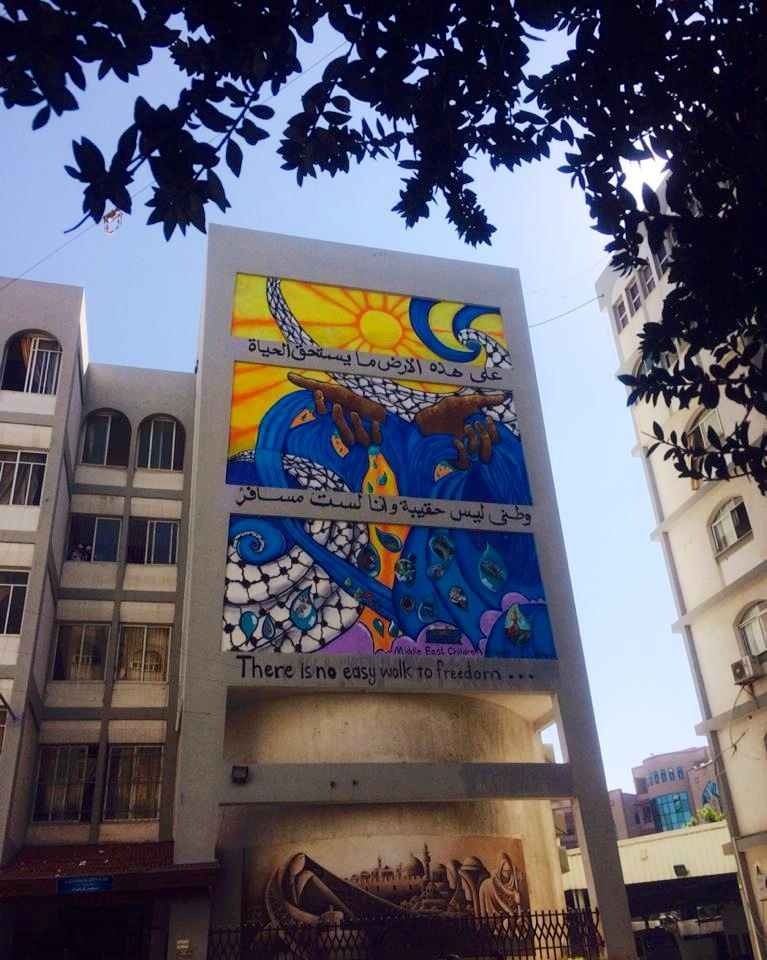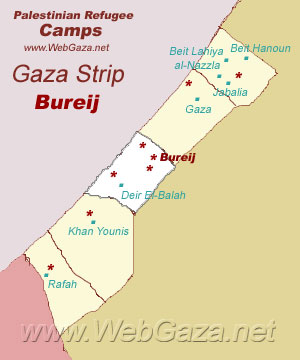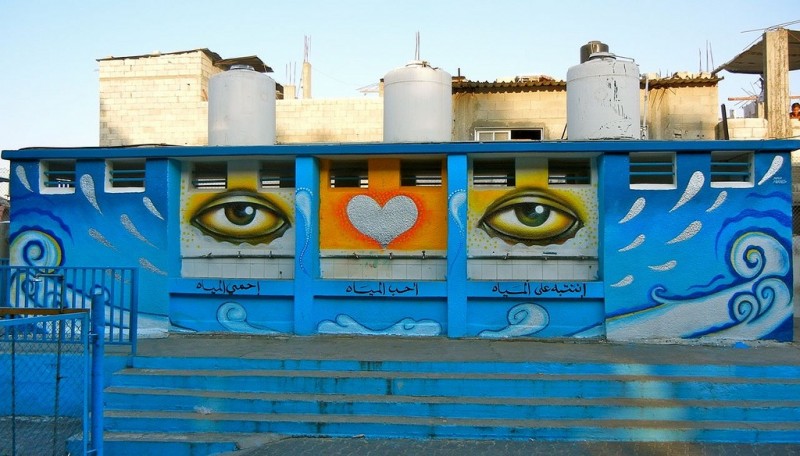 Round Table Discussion curated by Art Forces
Round Table Discussion curated by Art Forces
FREE
Intersection for the Arts
925 Mission St.
San Francisco, CA 94110
Wednesday, March 19, 2014, 7pm
Mapping Environmental (In) Justice is Art Forces’ ongoing investigation into the global dynamics of precarity, societal instability and violence, environmental destruction and creativity.
Maia Mural Brigade is a series of community mural projects located in refugee camps and towns in the Gaza Strip, Palestine. Maia Mural Brigade is a collaboration between Art Forces and the Middle East Children’s Alliance (MECA) and in 2011 with #WaterWrites project of the Estria Foundation. The murals are located at the sites of water purification and desalination systems installed with grassroots funding by MECA. To date 52 systems are providing clean water to more than 57,000 children and their families.
ABOUT THE PARTICIPANTS
Art Forces, previously Break the Silence Media & Art Project (BTS/MAP) uses community public art and technology, including murals, websites, social and new media, to create spaces for critical thinking and action. BTS/MAP moves from the local to the global, from the streets of San Francisco to refugee camps of Palestine. The projects make visible histories and relationships that have been obliterated and forgotten; making connections to national and global issues of social justice, borders, precarity, migrations and decolonization.
Ziad Abbas,associate director of MECA will discuss MAIA project. There is a growing water crisis in Palestine that affects agriculture, industry, and the health of virtually every adult and child. In the Gaza Strip, poor sanitation and over-extraction have polluted the limited water supply. In September 2009, the Middle East Children’s Alliance (MECA) launched the Maia Project (Arabic for “water”) to provide Palestinian children with clean, safe drinking water.
MECA is working in partnership with community organizations in Gaza to build water purification and desalination units in schools throughout the Gaza Strip.We have provided clean water to 26 large UN schools in Palestinian refugee camps and to 26 kindergartens in refugee camps, towns, and villages.
#WaterWrites Water Writes, a project of Estria Foundation, is an international series of collaborative murals about critical water issues.
The mural we focus on for this event is located along the Klamath River, where the largest dam removal project ever is in motion after an advocacy campaign lead by local native tribes and environmentalists. The mural portrays the Northern California Native people’s stomp dances that bring balance to the world. The dancer’s movements are breaking down the cement of the dams that block the Klamath River and prevent the salmon from swimming upstream to spawn. Watch a video about the project here.
Stop the Jewish National Fund Campaign “Stop the JNF” is an international campaign aimed at ending the role of the Jewish National Fund (Keren Kayemet LeIsrael) (JNF-KKL) in: 1.) the destruction of the natural environment in Palestine and Israel; 2.) the on-going displacement of indigenous Palestinians from their land; 3. ) the theft of their property; 4.) the funding of historic and present day colonies.
Between earth and earth’s atmosphere, the amount of water remains constant; there is never a drop more, never a drop less. This is a story of circular infinity, of a planet birthing itself. ~Linda Hogan, Chickasaw
R E S U R F A C I N G
Art. Activism. Mapping Environmental Justice.
Pls. Note- Exhibit and Events are still in Development
Mission Cultural Center for Latino Arts
January 15 -February 21, 2014
We live within multiple layers that are hidden from view; layers of history, stories, cultural movements and geography. Using the stories, poetics and politics of water, “Resurfacing” interrogates global environmental systems and the ways in which they are culturally and socially produced, supported, resisted and transformed. “Resurfacing” is envisioned as an inter-disciplinary interactive exhibit, project-space and conference. “Resurfacing” maps parallels and connections between seemingly distant locations and issues; and aims to create and support relationships and production that will develop beyond the length of the exhibit.
Interdisciplinary/Multi-Media/Installation (Selected)
Estria Foundations #Water Writes (selected)
Images of seven collaborative murals about water rights in seven cities around the world. Accompanied by videos providing stories and context.www.estria.org
Maia Mural Brigade (slected)
Wall size images of nine collaborative international murals painted in Gaza with Art Forces/Break the Silence Media, Middle East Children’s Alliance and Estria Foundation #Water Writes (2011). www.maiamuralproject.org Accompanied by Videos providing stories and context. 2011-2013
Joel Bergner
Wall size image of collaborative mural about water in refugee camp in Jordan. With video providing stories and context. http://joelartista.com.
Zapantera Negra
Exploration of the artistic and political connections between the Black Panther Party and the Zapatista movements as incubated in San Cristóbal de las Casas, Chiapas, Mexico. Featuring work created by Emory Douglas in collaboration with Zapatista artists. Graphics, embroidery, video of performative social sculpture. www.edelo.org/#/zapantera-negra/4571745556.
Mona Caron
http://legacy.monacaron.com/index.shtml Mural created in April 2010 for the 3rd Feria Del Agua, coinciding with the 10th anniversary of the Water War in Cochabamba, Bolivia.
http://legacy.monacaron.com/cochabamba/index.shtml
Boycott ~The Art of Economic Activism
Posters from Historical & Contemporary Boycott Movements
Organized by American Friends Service Committee. Audio element from each of the movements represented that include: Grape Boycott by US Farmworkers; Anti-Apartheid Boycott of South Africa; Palestinian Boycott, Divestment and Sanction movement.
Radical Geography
Susan Greene, in consultation with radical cartographers and geographers will create an interactive map. What environmental issues face the Bay Area currently? How are different geographic locations connected? Who is affected most? Who profits?
Middle East Children’s Alliance MAIA Project
The goal of MECA’s Maia Project is to provide safe clean, drinking water for tens of thousands of Palestinian children by working in partnership with community organizations to build water purification and desalination units in schools and towns throughout the Gaza Strip.MECA has provided clean water to 16 large UN schools in Palestinian refugee camps and to 22 kindergartens in refugee camps, towns, and villages giving 34,000 children access to clean water.
EWASH
The Emergency Water, Sanitation and Hygiene group (EWASH) is a coalition of almost 30 organizations working in the water and sanitation sector in the occupied Palestinian territory. EWASH is a coordination body seeking to improve Water, Sanitation and Hygiene conditions in the occupied Palestinian territory (oPt) and minimize the adverse effect of the political situation on the Water, Sanitation and Hygiene sector. www.ewash.org.
Stop the Jewish National Fund Campaign
International Jewish Anti-Zionist Network
Culture jamming public-art interventions and graphic descriptions of situation in Negev.
Palestine Mural in Oakland
Presentations and Design workshops for mural about Palestine and water rights in downtown Oakland. Sponsored by NorCal Sabeel, Estria Foundation.
Culture Jamming
Public-art ‘interventions’
Alliance for Climate Education
Youth film
WaterWheel
Exploring water—as a topic and metaphor—Waterwheel is an interactive, collaborative platform for sharing media and ideas, performance and presentation. Waterwheel investigates and celebrates this constant yet volatile global resource, fundamental element, environmental issue, political dilemma, universal theme and symbol of life. It encourages you to explore and discover, share and collaborate, contribute and participate.
Waterwheel calls on everyone—performers and artists, scientists and environmentalists, students and academics, you and me, anyone and anywhere—to test the water, dive in, make a splash and start a wave. It provides a platform and forum for experience and exchange, expression and experimentation.
Waterwheel draws together different people, practices, places, media and modes of expression. There are no borders or boundaries. Waterwheel flows along its natural course.
Photography/Painting/Graphics
Flo Razowsky, photography
Highlighting documentation of US/Mexico border, Israel’s wall in Palestine, and the structures used to cut off Spanish Melilla from Morocco.
Nellie King Solomon, Painting
Investigations into California water politics and global oil industry. www.nelliekingsolomon.com
Shareef Sarhan, Photography
Co-founder of Window Gallery in Gaza City.
Gaza Community Mental Health Programme, Drawings
Children’s art-work from Gaza Strip.
Stay Human
Mural by Miranda Bergman
Jenny Lynn, Photography
Nidal El-Khairy, Graphics
Juan Fuentes, Prints, Graphics
Focusing on the figure or portrait as a means to tell a story, elaborating on the human condition. http://juanrfuentes.com.
Melanie Cervantes, Prints
Cofounder of Rebelde Dignidade, dignidadrebelde.com/
Jos Sances, Prints
Malaquias Montoya, Prints
Jesus Barraza, Prints
Others TBA
Film and Video (in development) screened in gallery
Pressure Points
In 2010, UC Berkeley students made history with a campaign urging divestment from companies aiding Israeli occupation. Metier Productions, Directed: Anne Paxton.
The Bottom Line
International grassroots campaigns against Polaroid, Shell, Barclay’s, General Motors, and others doing business in South Africa economically isolate the apartheid regime and become the first successful efforts to use economic pressure to help bring down a government. Directed: Connie Fields
Documentary video and photography
Hilary Hacker
Mapping Shatila
Fred Alvarado, Video
Gaza Above the Storm
Ain Media, Gaza Strip, Palestine. Film about recent flooding in Gaza.
Flying Paper, Screened in Theater Jan. 29th
Flying Paper is the uplifting story of Palestinian children in the Gaza Strip on a quest to shatter the Guinness World Record for the most kites ever flown. It showcases the creative resilience of these children making and flying kites despite the difficult realities they face in their daily lives. The film has been co-produced with young Palestinians in Gaza trained by the filmmakers through a youth media program called Voices Beyond Walls. Through the perspective of children and young people comes a story of determination and artistic expression as the youth in the film work together to achieve a shared goal.
While the record-breaking event is what drives the film’s narrative arc, it is the everyday stories of the young kite makers that will touch audiences through their humor and playful spirit. The film seeks to humanize the conflict through a touching cinematic rendering of the fascinating kite culture among children as a form of creative resistance in Gaza.
With Co-Director Roger Hill
www.flyingpaper.org
www.facebook.com/flyingpaper
Panels/Presentation Salon Series (in development)
Wednesday, January 15th, 6:30-9:30
Opening Celebration
with Audiopharmacy, Genny Lim, Lubna Morrar plus surprise guests
Wednesday, January 22, 6-8pm
Teach In and Art Party – Gallery
Surveillance, policing, prison and corporate complicity: let’s take action!
Wednesday, January 29th 7-9:30- Theater
Flying Paper, Sneak Preview, Film
Flying Paper is the uplifting story of Palestinian children in the Gaza Strip on a quest to shatter the Guinness World Record for the most kites ever flown. It showcases the creative resilience of these children making and flying kites despite the difficult realities they face in their daily lives. The film has been co-produced with young Palestinians in Gaza trained by the filmmakers through a youth media program called Voices Beyond Walls.
Wednesday February 5, 6:30-9 Gallery
New Palestine Mural in Uptown Oakland
Design and Concept Workshop
The Estria Foundation will be partnering with Friends of Sabeel North America, and ArtForces on a new collaborative mural project highlighting the Palestinian water crisis and international responses of solidarity on a large public wall in Uptown Oakland.
The mural will focus on water as the uniting theme across the mural and create a space for local community and artists to collaborate with a visiting artist from Palestine. We hope to develop imagery that will make these issues visible to the public of Oakland, and by ways of the internet, to the world.
Saturday, February 8th , 1:00-9:00 pm
Conference and Film Screening- Theater and Gallery
Privatization, Labor Rights, Human Rights, The Environment And The Veolia Group
A unique one-day conference bringing together activists from all around the world involved in union organizing, Environmental protection and Palestine solidarity to confront the French multinational Veolia/ Transdev and build community resistance to privatization, union busting and corporate profiteering form human rights violation. Evening show and film screening.
The Veolia Group is a French owned multi-national which plays a growing role in the world economy pushing privatization of water resources, transportation and other public services.
In the Bay Area Veolia has pushed for the privatization of water treatment in Richmond, California, which has led to union busting and environmental degradation.
Globally, the Veolia group is the largest water privatization company and various environmental groups have tracked its record of destruction and corruption. In the occupied West Bank, subsidiaries of the group operated segregated buses to illegal Israeli settlements, operated an illegal settler dump and ran a light rail system that sustains the Israeli settlements around Jerusalem.
Wednesday, February 12th, 6-9 Gallery
Round Table
Winning Divestment: Student Struggles for Peace
Dedicated to the memory of Nelson Mandela. A panel discussion will bring activists to address the power, controversy and effectiveness of divestment as a tool for economic activism in different movements: the movement against apartheid in South Africa, the struggle for Palestinian rights, the global movement to avert the climate crisis. Film clips and movement posters, followed by an open conversation.
Wednesday, Feb 19th, 6:30-9:30 Gallery
Closing Reception and
Art Forces Report Back on recent projects in Refugee Camps in Lebanon and Maia Mural Brigade in Gaza, Plus Special guests
Calendar of Events
| Date | Event | Brief Description | Location | Organizor |
| Weds,1.15.14 | Opening |
Gallery TalksMusic, spoken word , poetry- Audiopharmacy,Genny Lim, possibly Debke Dancing, poetryGalleryArt ForcesWeds, 1.22.14Panel and Art Event-BDS – HP Organizing, borders,Control, surveillance.GalleryAFSCWeds, 1.29.14Film-Sneak Preview- Flying PaperDocumentary about youth in Gaza winning Guiness record for kite flyingTheaterArt ForcesWeds, 2.5.14Mural Design Workshop for Oakland Mural GalleryEstria FndSat. 2/8
1-9pmConference and Film ScreeningPrivatization, Labor Rights, Human Rights, The Environment And The Veolia Group
Gallery and TheaterAFSC, Art ForcesWeds, 2.12.14Panel/round table, film clipsStudent Organizing BDS and Across MovementsGalleryAFCS
Students for Justice in Palestine Weds, 2.19.14Presentation- ClosingRecent Art Forces ProjectsGalleryArt Forces
Events to be scheduled and in development
- Gallery Tours for classes, Organized by Art Forces and Estria Foundation
- Gallery Talks, Organized by Art Forces.
- Panel or Round Table: Art and Activism, Art Forces, In development, Not confirmed
- Interactive evening event on Israel’s Worldwide Role : Organized by IJAN.
- Panel or Round Table with Screening “Planting Resistance to the Jewish National Fund” – 30 minute documentary on the JNF told mostly through video footage of Palestinians in ’48 and the West Bank with a presentation by Ziad Abbas and others. Organized by IJAN and MECA
- Explorations and demonstrations of alternative ways to desalinate and purify water for drinking.
- Education regarding resources, in particular water.
December 2013
Al Azhar University
MAIA Mural #9 (IN PROGRESS)
Art Forces
With Susan Greene, Fred Alvarado, Hilary Hacker, Louy Nijm,
Images contributed by:
Nellie King Solomon, Eric Drooker, Emory Douglas, #WaterWrites, Joel Bergner,
JOIN #WATER4GAZA CAMPAIGN & GLOBAL MOVEMENT FOR CLEAN WATER
We are working with Afaq Jadeeda, Middle East Children’s Alliance, American Friends Service Committee, EWASH, Gaza Community Mental Health Programme. Supporters include Estria Foundation #Water Writes project.
2.) Share the Indiegogo campaign link with your community in order to help us fund this important movement. http://igg.me/at/
3.) Add your voice to the #Water4Gaza conversation by tweeting
Consider a donation to the MECA’s MAIA Project
http://www.mecaforpeace.org/projects/maia-project
The Maia Project: Bringing Clean Water to the Children of Palestine
Bringing Clean Water to the Children of Palestine
There is a growing water crisis in Palestine that affects agriculture, industry, and the health of virtually every adult and child. In the Gaza Strip, poor sanitation and over-extraction have polluted the limited water supply. In September 2009, the Middle East Children’s Alliance (MECA) launched the Maia Project (Arabic for “water”) to provide Palestinian children with clean, safe drinking water.
This project began when the Student Parliament at the UN Boys’ School in Bureij Refugee Camp, Gaza were given the opportunity to choose one thing they most wanted for their school: They chose to have clean drinking water. MECA’s partner in Gaza heard about this vote and, after meeting with representatives from the school and the Student Parliament, came to MECA to see if we could respond to the children’s request for drinking water. MECA provided the funds to build a water purification and desalination unit for the school in 2007. (Read More)
 Join Campaigns Organized by EWASH – Emergency Water Sanitation and Hygiene In Occupied Palestine
Join Campaigns Organized by EWASH – Emergency Water Sanitation and Hygiene In Occupied Palestine
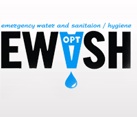
http://www.ewash.org/en/
Photo Petition:
http://www.thirstingforjustice.org/
Plant-a-Tree in Palestine
 Please honor special occasions, significant dates, holidays, and loved ones by planting a tree in Palestine.
Please honor special occasions, significant dates, holidays, and loved ones by planting a tree in Palestine.
The Plant-a-Tree in Palestine project is a joint project of the Middle East Children’s Alliance, Stop the Wall, the Palestinian Farmer’s Union, and the International Jewish Anti-Zionist Network.
The project is part of the campaign to stop the Jewish National Fund (JNF). For over 110 years the JNF has played a central role in the on-going displacement and dispossession of Palestinians from their land and homes.
The JNF is most commonly known for its campaign to ‘plant a tree in Israel’ in order to ‘make the desert bloom.’ However, the JNF trees have never been planted in a barren desert empty of inhabitants that Jewish people have come to populate and make flourish. Lands were, and still are, obtained from their Palestinian inhabitants through exploitative land sales, forced removal or other apartheid State policies.
It is not possible to replace what is lost when people are displaced, land and a way of life is destroyed, 1,000 year old olive trees uprooted. In Palestine scores of 2,000-year-old cities and historical sites are buried under JNF planted forests and parks. Rebuilding and replanting are acts of daily resistance in Palestine.
This project seeks to support the on-going struggle of Palestinians to rebuild by providing resources for villages to plant trees that are indigenous to Palestine’s natural environment and agricultural life.
When a critical mass of trees has been purchased, Stop the Wall and the Palestinian Farmer’s Union will coordinate planting days. On these days, the Farmer’s Union will deliver the trees. With community members joined by their fellow Palestinians and international volunteers, they will spend a day replanting trees in villages and homes that had their trees uprooted by the Israeli military and/or the Jewish National Fund.
Over time, the project will expand to collect funds for gardens in schools, playgrounds and community spaces that the JNF and State of Israel have also attempted to destroy.
The Partners
 The Palestinian grassroots Anti-Apartheid Wall Campaign (Stop the Wall) is a coalition of popular committees, youth activists, and Palestinian non-governmental organizations that acts as the voice of local communities; mobilizes and coordinates national actions; and is part of the global struggle against colonialism, war and racism. Stop the Wall’s efforts to tear down the Wall and achieve reparations for the damages and harm caused by its construction are an integral part of the Palestinian struggle for justice, liberation and return of the refugees. Stop the Wall promotes boycotts, divestments and sanctions (BDS) as a core part of international solidarity with the Palestinian people.
The Palestinian grassroots Anti-Apartheid Wall Campaign (Stop the Wall) is a coalition of popular committees, youth activists, and Palestinian non-governmental organizations that acts as the voice of local communities; mobilizes and coordinates national actions; and is part of the global struggle against colonialism, war and racism. Stop the Wall’s efforts to tear down the Wall and achieve reparations for the damages and harm caused by its construction are an integral part of the Palestinian struggle for justice, liberation and return of the refugees. Stop the Wall promotes boycotts, divestments and sanctions (BDS) as a core part of international solidarity with the Palestinian people.
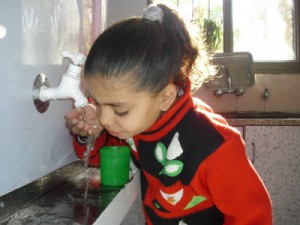
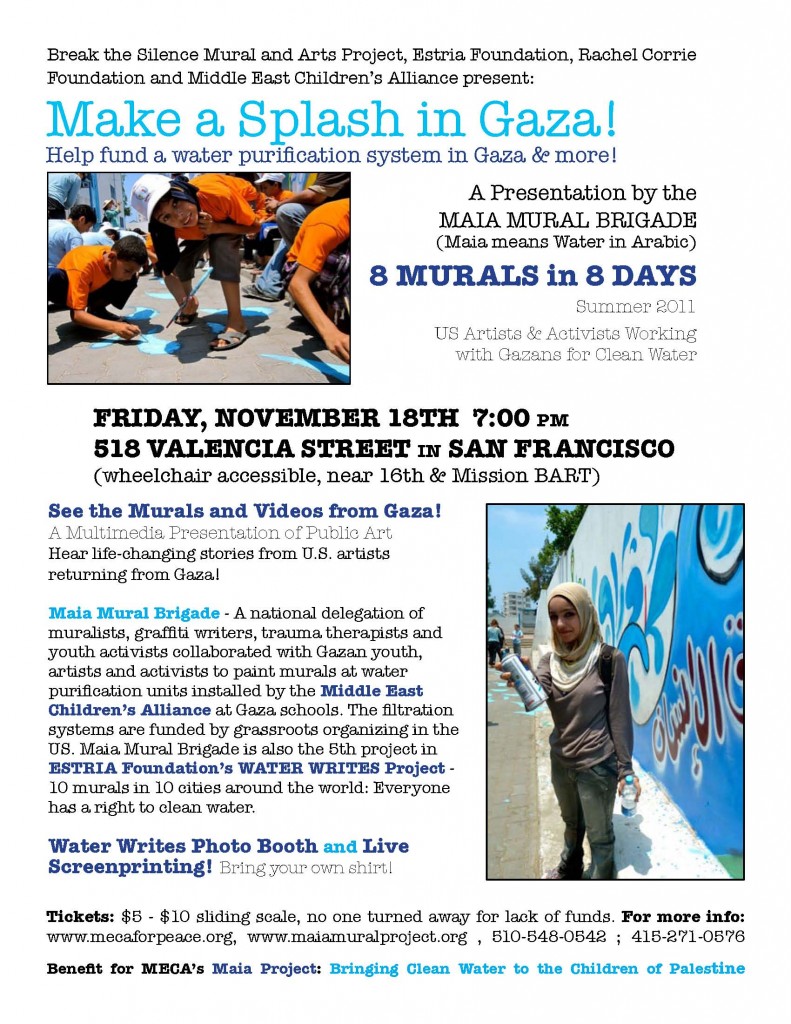 The Palestinian Farmers Union(PFU) works to organize and build the capacity of local farmers to defend their rights. PFU supports farmers in their just cause against the apartheid wall and the confiscation of land and water for the benefit of illegal Israeli settlements. PFU projects strengthen the economic development of the Palestinian agricultural sector and provide services to the Palestinian rural populations facing economic, social and financial difficulties.
The Palestinian Farmers Union(PFU) works to organize and build the capacity of local farmers to defend their rights. PFU supports farmers in their just cause against the apartheid wall and the confiscation of land and water for the benefit of illegal Israeli settlements. PFU projects strengthen the economic development of the Palestinian agricultural sector and provide services to the Palestinian rural populations facing economic, social and financial difficulties.
1 – Write a banner with a message in support of Palestinian rights to water and sanitation including the name of our campaign “Thirsting for Justice”2 – Take a photo holding the banner. Email your photo as an attachment to [email protected] . Make sure you include your name and city.
3 – We’ll post your photo on our site and use it to show elected leaders that their constituents want urgent action in support of Palestinian rights. Send us your photos by 1 July 2011
Bringing Clean Water to the Children of Palestine
There is a growing water crisis in Palestine that affects agriculture, industry, and the health of virtually every adult and child. In the Gaza Strip, poor sanitation and over-extraction have polluted the limited water supply. In September 2009, the Middle East Children’s Alliance (MECA) launched the Maia Project (Arabic for “water”) to provide Palestinian children with clean, safe drinking water.
This project began when the Student Parliament at the UN Boys’ School in Bureij Refugee Camp, Gaza were given the opportunity to choose one thing they most wanted for their school: They chose to have clean drinking water. MECA’s partner in Gaza heard about this vote and, after meeting with representatives from the school and the Student Parliament, came to MECA to see if we could respond to the children’s request for drinking water. MECA provided the funds to build a water purification and desalination unit for the school in 2007.
MECA is working in partnership with community organizations in Gaza to build water purification and desalination units in schools throughout the Gaza Strip. We have provided clean water to 14 large UN schools in Palestinian refugee camps and to 13 kindergartens in refugee camps, towns, and villages.
MECA is seeking supporters to expand the Maia Project to schools throughout Gaza. A large purification unit for a UN school in a refugee camp costs $11,500. The UN schools run in shifts due to overcrowding and each unit provides drinking water for 1,500-2,000 children and staff. A small purification unit for a preschool or kindergarten costs $4,000 and serves 150-450 children. Many organizations, individuals, and schools around the US are raising the whole cost of a unit in their communities.
You can help!
- Sponsor a school or kindergarten in Gaza: Consider creating a group at your school or in your community to raise funds and build a connection with a “sister school” in Gaza. Email Josie if you would like more information.
- Make a secure online contribution to the Maia Project. New projects will begin as funds are raised.
- Buy a Maia Project water bottle! Help the environment and children in Palestine with a reusable water bottle.
- Organize a house party or event to raise awareness about the water crisis in Palestine.
- Sign the “Clean Water for Children in Palestine” petition asking President Obama to put pressure on Israel so that Palestinian children can have access to clean drinking water.
- Support the Palestinian call for Boycott, Divestment, and Sanctions of Israel until it complies with international law.






